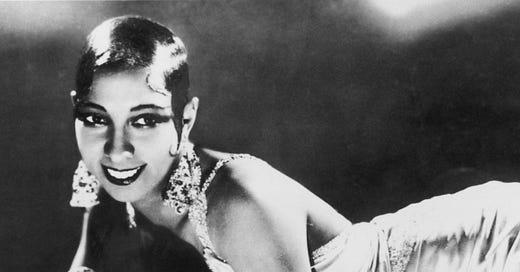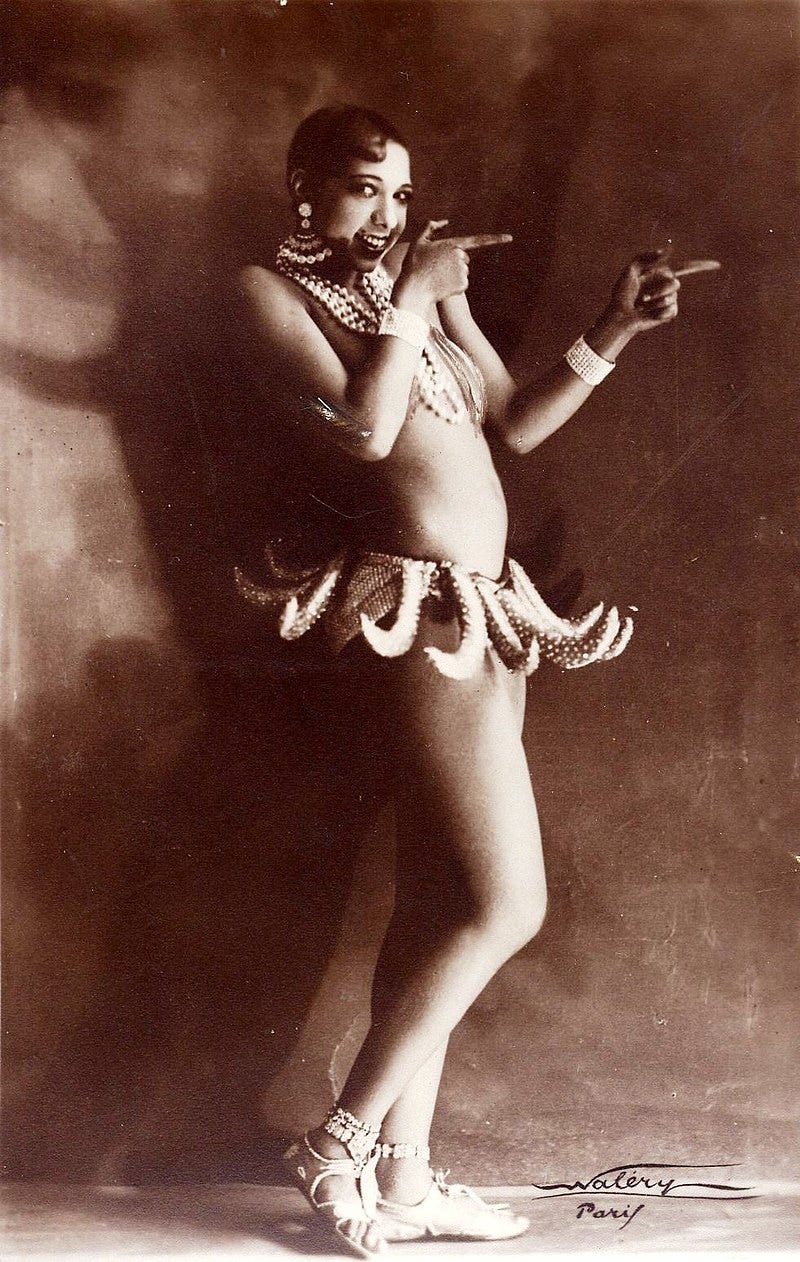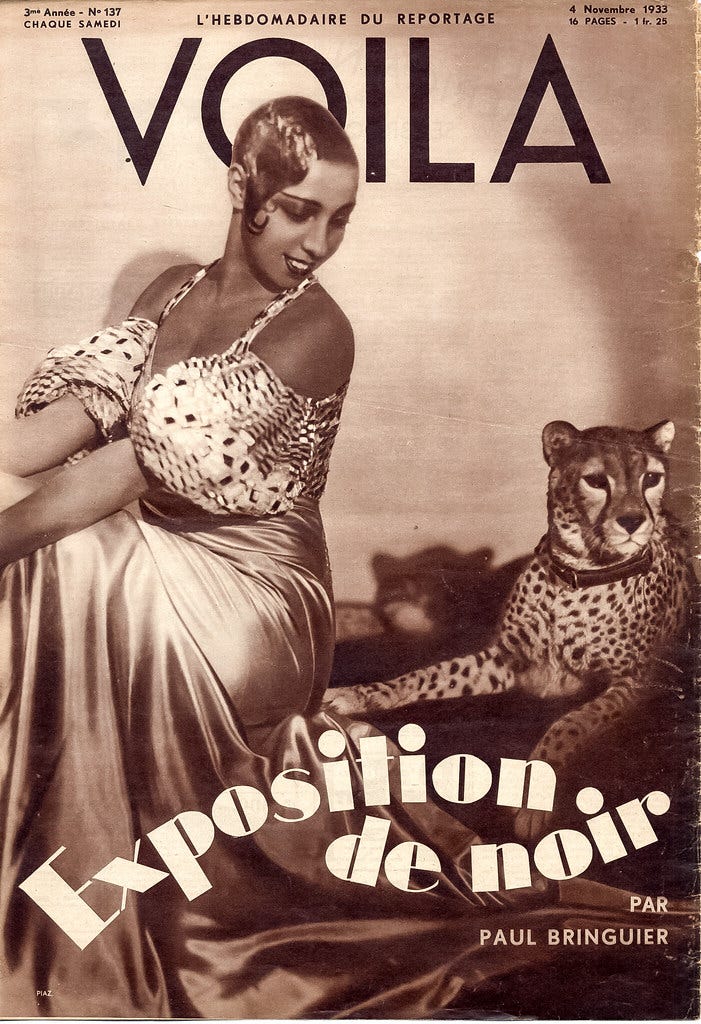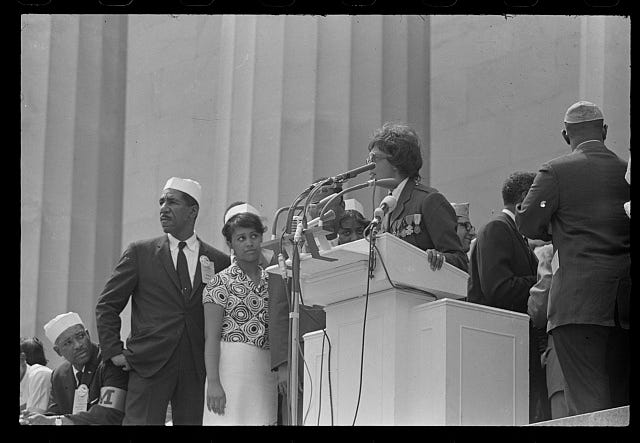A Vaudeville Performer Turned French Spy and Civil Rights Activist
Oh, and she had A PET CHEETAH
Hi, friends 👋🏻
Before we get started, can you share this newsletter with one person? I have a goal to increase my subscribers to 1,000 by the end of the year and the best way to do that is through reader promotion! TY 💖
Now, on to the good stuff! Remember a few weeks ago when I polled you all about who you’d like to see covered in a future newsletter? The highest vote count was for Josephine Baker… so here… we… go!
Josephine Baker ✨
In 1906, Josephine Baker was born Freda Josephine McDonald in St. Louis, Missouri. Her early life is a bit hard to track (and frankly, very bleak), but here’s what I could easily find. Josephine grew up in a poor family and was put to work at a young age. At eight years old, she began to work as a domestic worker in a white family’s home. At eleven, she witnessed the burning of several Black families homes. That incident stuck with her and later fueled her activism work. Throughout her childhood, she continued to work and often lived on the street. She began working at the Old Chauffeur Club and married one of its patrons, Willie Wells, when she was 13. She divorced him after less than a year.
One of her most successful ventures for cash was performing dance routines in the street. Eventually, she caught the attention of a performing group, Jones Family Band, and began performing with them. She also married her second husband (William Howard Baker) at 15, which is where she got her stage name of Baker. She kept the stage name after their divorce. When the Jones Family Band was asked to perform in New York City, she packed her bags for the Big Apple! She was a very successful performer, even for her young age, and figured out how to make herself stand out by adding a bit of comedy to her moves. She performed in touring shows and on Broadway, but only in the chorus. Hungry for something bigger, she set her sights on Paris.
At 19, Josephine was off to Paris to perform as the lead in La Revue Nègre. She was one of the first Black American dancers to move to France to achieve success… and boy did she achieve it! She was known for “erotic dancing.” Basically, dancing with minimal clothes on. See below for her famous banana skirt. I wonder what the citizens of 1930s France would think about crop tops…
Josephine starred in several shows and was soon called the most successful American performer in France. Famous artists of the time were obsessed with her style and talent. Her signature hairstyle (short with curls lining the face) became a trend.
In one of her shows, she would bring her pet cheetah (yes, PET CHEETAH) Chiquita on the stage adorned in a diamond collar. Because naturally cheetahs should have diamond collars. Sometimes Chiquita would get loose and jump into the orchestra pit and scare the shit out of the musicians while delighting the audience. She also walked Chiquita in the streets of Paris (see Google for pics, I limited myself to one Chiquita pic in this edition).
During this time, Josephine became one of the biggest stars in France. She starred in several films, debuted original music, and viewed herself as completely integrated into French culture. While in America, Josephine often cited her lack of success on Broadway and other venues because of racial discrimination. But, she loved Paris because it allowed her to be free. She later married a Frenchmen, Jean Lion, and became a French citizen. It’s important to mention Josephine was bisexual, but she often kept her relationships with women on the down low for fear it would impact her career.
During WWII, Josephine was living in France when the Nazis occupied Paris and joined the resistance movement. She would perform for enemy audiences. While performing, she would overhear critical information from the military officers. She would write down any helpful tidbits she heard using invisible ink on her music sheets or pin notes in her clothes and pass it along to the French military. She would also socialize with enemy officers at galas and parties and report back any information she heard. She was the perfect spy because no one suspected her, likely due to their own bias. She received the Croix de Guerre, awarded for heroic deeds, for her work.
After the war, Baker returned to her performing roots. In the 1950s she was invited to the United States to perform in Miami. The performance was so successful, she began a national tour throughout the US. She started to gain immense national recognition in the US and was named NAACP’s “Woman of the Year.” Baker also made headlines because of her refusal to perform for segregated audiences and her unabashed support of the Civil Rights Movement.
Unfortunately, Baker also faced blatant discrimination in the US. She was often denied stays in hotels and she repeatedly received threatening calls from the KKK. One night, she was refused service at the Stork Club (a famous club in NYC) and called out their unwritten policy of denying Black patrons + she called out a well-known reporter (Walter Winchell) for not writing about it. He retaliated by writing terrible reviews of Baker’s performances and also accused her of being a communist. This got her work visa revoked and she wasn’t allowed back in the US for 10 years. She later returned and was the only official female speaker at the 1963 March on Washington. It’s reported that Coretta Scott King asked Baker if she would consider taking over for her husband in the movement, but Baker declined as she didn’t want to potentially leave her kids without a mother.
Baker continued to perform for sold-out audiences, but struggled financially as she aged. She died several days after a sold-out performance celebrating her 50 years in show business. Apparently, the event was so popular they had to bring in additional folding chairs for audience members to sit in.
There are so many other amazing bits I couldn’t squish into this week’s issue such as…
👑 Josephine Baker’s friendship with Princess Grace Kelly of Monaco
👶 Raising + adopting 13 children (no one seems to know the exact number, some say 11, some say 12), which she called the “Rainbow Tribe” because of their racial and ethnic diversity
💖 Her rumored affair with Frida Kahlo
If you’re interested in learning more about Josephine Baker, there is tons I was not able to cover! And luckily for you, there are ample books, movies and documentaries about her.
Bits and Bobs 🧵
💰 Read about Lyn Jones, a high school student in Richmond, VA working to fund the menstrual product dispensers at her school. Spoiler: the state was supposed to do it and did not 😾
✨ Forbes recently interviewed six women philanthropists changing the world.
📚 New book alert! The first major biography of Jeanette Rankin, the first woman in Congress, is coming out in November! The best way to help books succeed is pre-order!
🥪 Vegans in Atlanta rejoice! After losing her first business to creditors, Pinky Cole is back with a vegan sub shop aptly named “Voagies.”
That’s all for today. TTFN!
Citations
https://en.wikipedia.org/wiki/Josephine_Baker
https://www.womenshistory.org/education-resources/biographies/josephine-baker
https://nmaahc.si.edu/josephine-baker
https://www.biography.com/artists/frida-kahlo-real-rumored-affairs-men-women
https://info.umkc.edu/womenc/2018/02/26/the-activism-of-josephine-baker/







How did I not know about Chiquita!! Thank for the beautiful image of Chiquita terrifying the musicians, and now I need to find many more stories and photos about her
She also has a memoir! Fearless and Free. I haven’t read but listened to a summary of it and it sounds good!